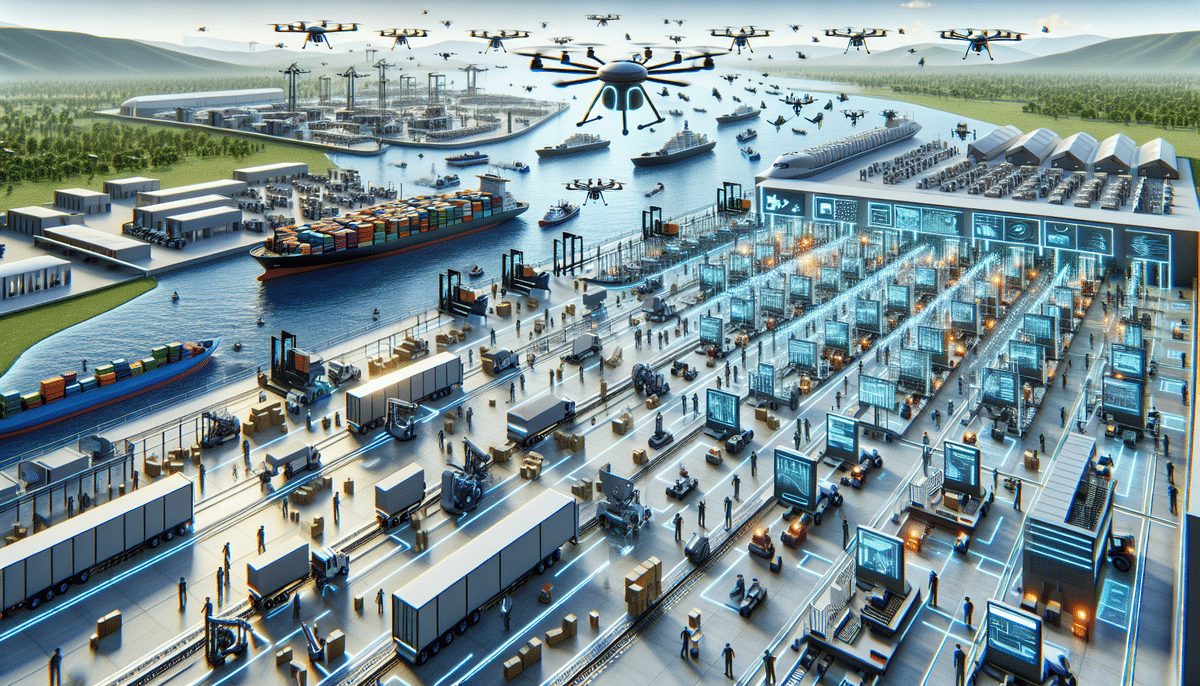What Is a 3PL System? A Comprehensive Definition and Process of Third Party Logistics
The world of logistics is a complex ecosystem composed of multiple players and systems working collaboratively to ensure that goods are delivered to the right place, at the right time, and in optimal condition. A crucial participant in this framework is the third-party logistics provider, commonly referred to as a 3PL. This article delves into the intricacies of 3PL systems, their evolution, benefits, service types, selection criteria, implementation processes, challenges, industry trends, future opportunities, real-life case studies, and best practices for managing and optimizing your 3PL system.
The Evolution of Third Party Logistics and Its Benefits
3PL systems have a long history, but their significance has surged in recent years as businesses recognize the strategic advantages they offer. Historically, companies managed their logistics operations in-house, but the rise of globalization and e-commerce has made this approach increasingly challenging and costly.
Utilizing a 3PL system offers numerous benefits. It allows companies to reallocate resources that would otherwise be dedicated to internal logistics management. 3PL providers leverage their scale and expertise to negotiate favorable rates with carriers, passing these savings on to their clients. Additionally, 3PL providers offer access to a broader range of transportation options, enabling businesses to select the most efficient method—be it air, sea, or land—for each shipment.
Another advantage is the enhanced flexibility and scalability that 3PL systems provide. As businesses grow and their logistics needs evolve, 3PL providers can adapt more readily than in-house teams. Moreover, 3PL providers often offer customized solutions tailored to specific requirements, such as specialized handling or unique delivery schedules.
According to the Statista report (2023), the global 3PL market size is projected to reach over $1.3 trillion by 2027, highlighting the expanding role of 3PLs in global supply chains.
Understanding the Different Types of 3PL Services Available
3PL services are diverse, each catering to specific logistical needs. The most fundamental type is the transportation provider, responsible for moving goods from one location to another. Warehouse providers manage the storage and distribution of goods, ensuring efficient inventory management.
Other specialized 3PL services include:
- Freight Forwarders: Coordinate the movement of goods across various transportation modes and international boundaries.
- Customs Brokers: Assist businesses in navigating complex customs regulations.
- Value-Added Service Providers: Offer additional services like packaging, labeling, and assembly.
A critical factor when selecting a 3PL provider is their technological capability. Advanced providers invest in technologies such as Warehouse Management Systems (WMS) and Transportation Management Systems (TMS) to streamline operations and enhance efficiency. In contrast, providers relying on manual processes may experience slower operations and higher error rates.
Customer service quality is another pivotal consideration. Providers offering dedicated account managers can deliver personalized service tailored to a client’s needs, whereas those with a more generic approach may not meet the specific support and communication requirements of all businesses.
How to Choose the Right 3PL Provider for Your Business Needs
Selecting the appropriate 3PL provider is vital, as an unsuitable choice can lead to increased costs, delays, and potential reputational damage. Key factors to evaluate include the provider’s industry-specific experience, track record of success, technical capabilities, geographic coverage, and overall flexibility and responsiveness.
It’s essential to scrutinize the provider’s pricing structure and contractual terms. Understanding the complete cost of services, including any hidden fees or additional charges, is crucial. Additionally, reviewing the provider’s service-level agreements (SLAs) ensures they align with your business requirements.
Customer service is paramount when choosing a 3PL provider. A responsive and communicative provider can significantly influence your business’s success. Look for providers that offer dedicated account managers or customer service representatives capable of promptly addressing any issues or concerns.
Refer to the Inbound Logistics guide for comprehensive criteria on selecting the right 3PL provider.
A Step-by-Step Guide to Implementing a Successful 3PL System
Implementing a 3PL system involves several critical steps, each requiring meticulous planning and execution. Begin by defining your logistics requirements and identifying areas where a 3PL can add the most value. This foundational step sets the stage for selecting a suitable provider.
After selecting a provider, collaborate closely to ensure a seamless transition. This collaboration may include training your staff, integrating your systems with the provider’s technology, and establishing effective communication channels.
Establishing clear performance metrics and Key Performance Indicators (KPIs) is essential to measure the system’s effectiveness. These metrics help identify areas for improvement and ensure the 3PL system delivers the anticipated benefits.
Regularly reviewing and evaluating your 3PL provider’s performance is crucial. Conducting periodic audits, reviewing SLAs, and soliciting feedback from customers can help ensure the provider meets your expectations and continues to deliver value.
For a detailed implementation strategy, consult the Supply Chain Digital tips.
Common Challenges Faced by Companies While Adopting a 3PL System
While 3PL systems offer substantial benefits, their adoption can present several challenges. Common issues include data integration problems, communication breakdowns between the company and the 3PL provider, and employee resistance to new processes.
Effective communication is key to overcoming these challenges. Engaging all stakeholders from the beginning and establishing clear communication lines and expectations can mitigate many potential issues.
Another challenge is the need for additional training and education. Employees may require training to adapt to new systems and procedures, and allocating adequate time and resources for this training is vital for a smooth transition.
The Forbes article outlines strategies to address these common challenges effectively.
Top Trends in the 3PL Industry and What They Mean for Your Business
The logistics industry is continually evolving, with several key trends shaping the future of 3PL. The increasing integration of advanced technologies, including Artificial Intelligence (AI), Machine Learning, and the Internet of Things (IoT), is transforming 3PL operations. These technologies enhance efficiency, provide better data insights, and improve overall service quality.
Sustainability is another critical trend, with companies seeking ways to minimize their environmental impact. This shift drives 3PL providers to adopt greener practices, such as utilizing electric vehicles and optimizing delivery routes to reduce emissions.
Data analytics is becoming increasingly important, enabling 3PL providers to offer more informed and strategic logistics solutions. The rise of e-commerce and omnichannel retailing is also influencing 3PL services, as businesses demand faster, more flexible delivery options.
A significant trend is the move towards a customer-centric approach. 3PL providers are focusing on personalized services to meet the unique needs of each client, driven by the demands of e-commerce for reliable and flexible delivery solutions.
The adoption of blockchain technology is another emerging trend, offering a secure and transparent platform for tracking goods and managing transactions. This technology can reduce costs, increase efficiency, and enhance supply chain visibility.
For more insights on industry trends, refer to the McKinsey report on the future of logistics.
The Future of Third Party Logistics: Predictions and Opportunities
The future of the 3PL industry looks promising, with ample opportunities for growth and innovation. As e-commerce continues to expand and supply chains become more intricate, the demand for third-party logistics providers is expected to rise.
Emerging technologies like blockchain and autonomous vehicles are set to revolutionize the industry, offering new avenues for efficiency and cost savings. Companies must stay ahead by embracing these technologies to maintain competitiveness.
Sustainability will play an increasingly significant role in shaping the future of 3PL. With consumers demanding environmentally responsible practices, 3PL providers need to adopt sustainable operations, such as using electric vehicles and optimizing delivery routes to lower their carbon footprint.
The COVID-19 pandemic underscored the importance of supply chain resilience. Future 3PL providers must be agile, capable of adapting to disruptions like border closures or lockdowns. Developing robust contingency plans and utilizing alternative transportation modes will be essential for maintaining uninterrupted supply chains.
According to a PwC report, technological advancements and sustainability will be the primary drivers of growth in the 3PL sector over the next decade.
Case Studies: Real-Life Examples of Successful 3PL Implementations
Examining real-life case studies offers valuable insights into the practical benefits and challenges of 3PL implementation.
- Levi Strauss: The apparel giant successfully reduced its logistics costs by 20% after implementing a 3PL system, enhancing efficiency and reducing overhead.
- L'Oréal: The cosmetics leader achieved a 25% reduction in lead times and improved order accuracy to 98% by partnering with a 3PL provider, streamlining their distribution process.
- Amazon: Leveraging multiple 3PL providers has enabled Amazon to offer faster delivery times and expand its global reach, maintaining its competitive edge in the e-commerce market.
These examples demonstrate the tangible benefits that effective 3PL partnerships can bring to businesses across various industries.
Best Practices for Managing and Optimizing Your 3PL System
To ensure your 3PL system operates efficiently, ongoing monitoring and optimization are essential. Establish clear performance metrics, regularly review your contract with the provider, and stay informed about new technologies and industry trends.
Maintaining open communication with your 3PL provider is crucial. Collaborate closely to identify areas for improvement and implement necessary changes. By adhering to these best practices, you can ensure your 3PL system continues to deliver value and meets your business needs in the long term.
- Set Clear Expectations: Define roles, responsibilities, and performance metrics from the outset.
- Foster Collaborative Relationships: Build a partnership mentality with your 3PL provider to enhance cooperation and problem-solving.
- Leverage Technology: Utilize integrated systems for real-time tracking and data sharing.
- Continuous Improvement: Regularly assess performance and seek opportunities for enhancement.
In conclusion, a 3PL system can offer substantial benefits to your business. However, it is imperative to carefully evaluate your options and select a provider that aligns with your unique needs and circumstances. By following the guidelines outlined in this article and embracing emerging trends and technologies, your company can thrive in the ever-evolving logistics landscape.




















